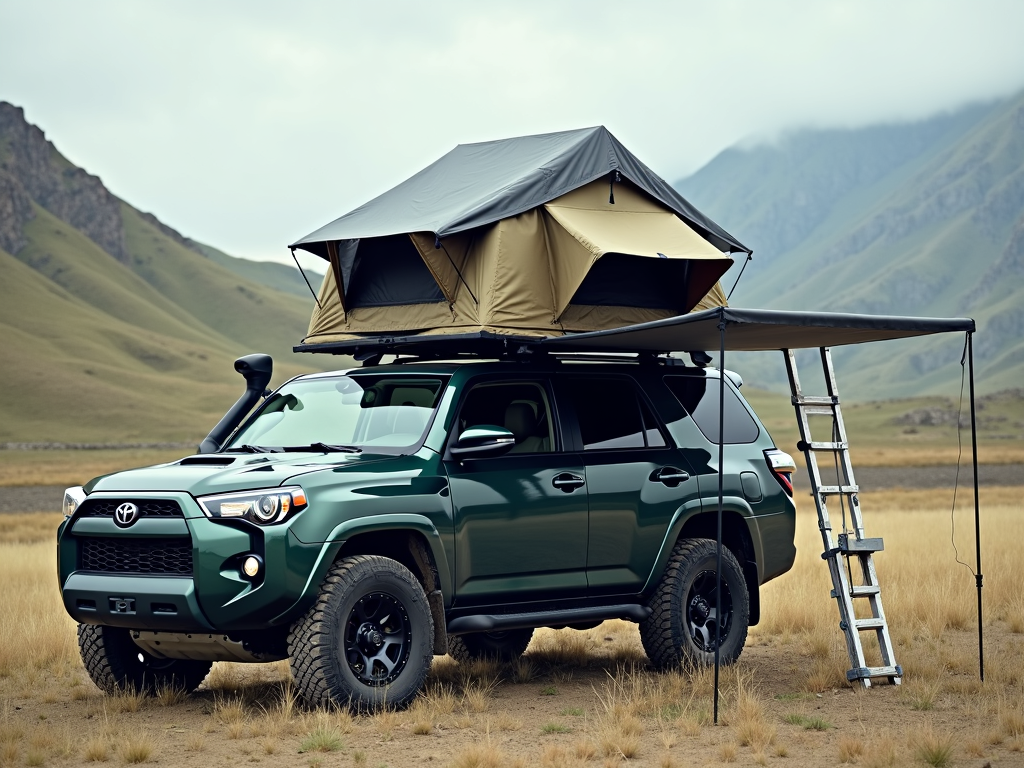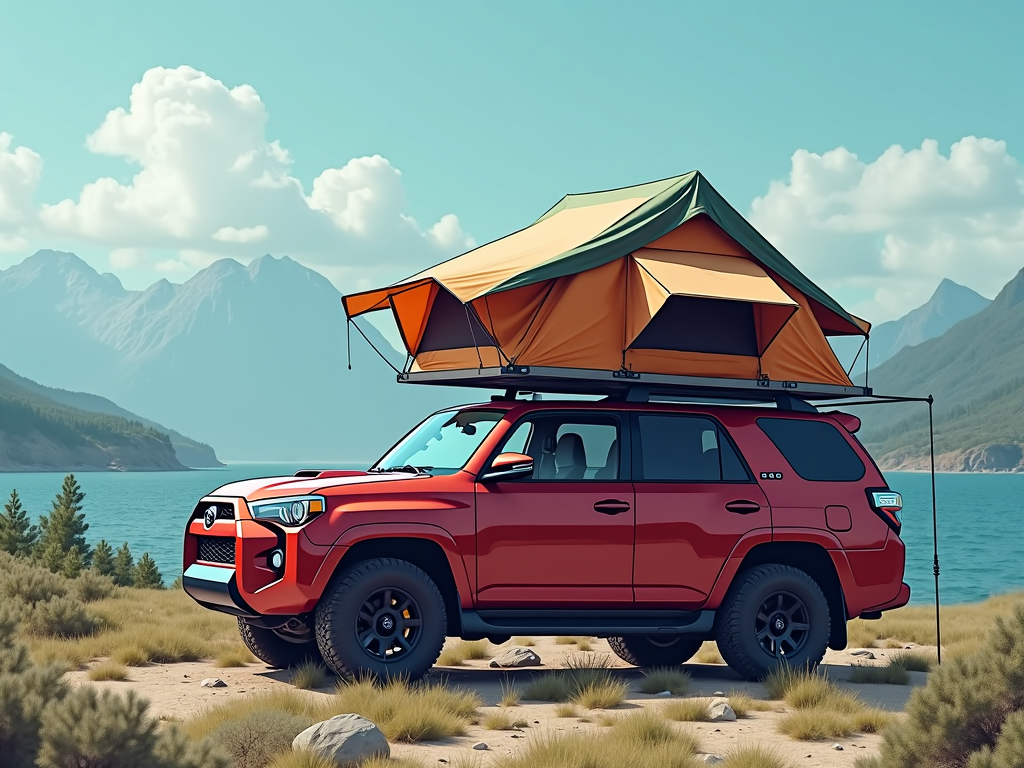Let me blow your mind for a second. That basic SUV tent you’ve been eyeing? It’s already outdated.
While you’re comparing prices and counting square feet, companies like IDOOGEN and KingCamp are cramming solar panels, USB hubs, and app-controlled climate systems into fabric walls. Yeah, you heard that right. The camping world went digital while we were still arguing about waterproof ratings.

Here’s the kicker – these aren’t gimmicky add-ons that break after one trip. The Galaxy Pro from Topoak Overland runs LED lighting systems off integrated solar for weeks. The Waterproof SUV Tent 10×8 Coumy now comes with built-in mounting points specifically designed for power stations.
We’re talking about turning your Toyota 4Runner into a legit mobile command center. Not just a place to crash after hiking.
This isn’t your dad’s Coleman setup anymore. The game has changed, and if you’re still shopping for SUV tents based on ‘does it keep rain out,’ you’re about three years behind. Time to catch up.
The Solar-Powered SUV Camping Setup: From Basic Shelter to Mobile Power Station
Remember when car camping meant draining your vehicle battery to charge one measly phone? Those days are dead. The latest SUV tents come pre-wired for solar integration. Not just ‘solar-ready’ – actually designed from the ground up to become power stations on wheels.
Take the Waterproof SUV Tent 10×8 Coumy. Looks basic from the outside, right? Wrong. Those innocent-looking grommets along the roofline? They’re reinforced mounting points rated for 200W solar panels. The interior features integrated cable management that routes power to USB hubs built into the tent walls. No more tripping over extension cords in the dark.
But here’s where it gets wild. Napier Outdoors just dropped their 2024 lineup with something they call ‘pass-through power architecture.’ Fancy words for: your solar panels charge a portable power station inside the tent while simultaneously powering LED strips, fans, and device charging ports. All weather-sealed. All modular.

The math is simple but mind-blowing. A basic 100W panel generates enough juice to run LED lighting for 40+ hours, charge six phones, power a portable fridge, and still have energy left over. Double that panel size – which these new tents easily accommodate – and you’re essentially off-grid indefinite.
Rightline Gear took it further. Their calculator app shows real-world power consumption based on your exact gear setup. Plug in your devices, camping style, and location. It spits out exactly what solar capacity you need. No guesswork. No hoping your setup works when you’re 50 miles from civilization.
The craziest part? This tech doesn’t add weight or complexity. Modern portable solar panels weigh less than 5 pounds. Power stations have shrunk to lunchbox size. The whole system sets up faster than inflating an air mattress. You’re literally plugging in like you would at home, except your power source is the sun and your living room is attached to your Jeep Wrangler.
But generating power is just the start. What happens when you can control everything from your phone?
Smart Features Transforming SUV Tents: App Control, Climate Management, and Safety Tech
Your Tent Has WiFi Now
Let that sink in. The KingCamp Melfi Plus doesn’t just give you a screen room – it gives you a smart hub that controls LED zones, monitors internal temperature, and alerts you if wind speeds get sketchy. All from an app that works whether you’re inside cooking dinner or out hiking nearby.
This isn’t Silicon Valley nonsense shoved into camping gear. These features solve real problems. Ever woken up at 3 AM because your tent turned into a sauna? The new climate management systems prevent that. Sensors track temperature and humidity, automatically opening vents or activating fans to maintain your preset comfort level. No manual adjustments. No suffering through temperature swings.
Topoak Overland’s Galaxy Pro rooftop tent shocked everyone with its lighting system. We’re not talking about basic LEDs here. The app lets you set lighting schedules, adjust brightness by zone, and even sync lights to your phone’s alarm. Wake up to gradually brightening ‘sunrise’ lighting instead of fumbling for a flashlight. It’s hotel-level comfort bolted to your Ford Explorer.
Security Got an Upgrade Too
Motion sensors can trigger lights or send alerts to your phone if something approaches your campsite. Some models integrate with portable security cameras, giving you a 360-degree view of your surroundings from inside the tent. Paranoid? Maybe. But also pretty sweet when you’re camping solo in bear country.
The integration goes deeper than you’d think. Sportz now makes tents that communicate with your vehicle’s systems. Your tent knows when you’ve locked the car, automatically activating its own security features. It can even tap into your vehicle’s battery monitoring to prevent accidental drain.
Here’s the reality check though – not all smart features are created equal. Some companies slap Bluetooth on a basic tent and call it ‘smart.’ Real innovation means features that enhance camping without creating new failure points. The good stuff works offline, doesn’t need constant updates, and has manual overrides for everything.
REI Co-op’s testing found that properly implemented smart features actually increase reliability. Why? Because they prevent the human errors that typically cause problems. Forget to close a vent before rain? The system handles it. Leave lights on all night? Auto-shutoff saves your battery. It’s like having a camping buddy who never forgets the important stuff.
Of course, all this tech sounds expensive and complicated. But here’s what nobody tells you about upgrading…
Avoiding Tech Pitfalls: Common Mistakes When Upgrading to High-Tech SUV Camping
Everyone thinks tech makes camping complicated. They’re wrong. The real problem? People buy the wrong tech for the wrong reasons. Let me save you some money and frustration.
First big mistake – assuming you need maximum everything. That 400W solar setup with 2000Wh battery bank? Overkill for weekend trips. Most campers use less than 200Wh per day. That’s running lights, charging phones, maybe a fan. Unless you’re powering a mobile office or medical equipment, start small. You can always add more later.
Weather resistance myths kill me. People think adding tech means sacrificing durability. IDOOGEN’s triple-expanding design proves otherwise. Their tents handle 60mph winds while running full electrical systems. The key? Proper weatherproofing from the start, not afterthought add-ons. Look for IP65-rated connections, sealed cable entry points, and components designed for temperature extremes.
Here’s a truth bomb – vehicle compatibility matters more than any feature list. That universal SUV tent with awesome tech? Worthless if it doesn’t properly mate with your specific ride. Minivan tent connectors differ from truck bed tent attachments. A hatchback tent attachment won’t work right on SUV tailgate tent mounting points. Do your homework or waste your money.
The power calculation mistakes are painful to watch. Everyone forgets phantom draw – devices pulling power even when ‘off.’ That USB hub? 5-10W continuous. LED controller? Another 3-5W. Add up five or six always-on devices and you’re burning 50W doing nothing. Smart systems with proper power management cut phantom draw by 90%.
Another pitfall – ignoring setup complexity in real conditions. That tent might set up easy in your driveway on a sunny day. Try it in the dark, in rain, when you’re exhausted. The best tech-enabled tents maintain simple setup procedures. If adding solar panels means 20 extra minutes of fiddling with connections, you bought the wrong system.
4 season SUV tent doesn’t mean 4 season electronics. Cold kills batteries. Heat fries circuits. Quality systems include thermal management – insulated battery compartments, ventilated control boxes, components rated for extreme temperatures. Cheap systems work great until they don’t, usually when you need them most.
The biggest mistake? Thinking you need to buy everything at once. Start with a solid tent that’s tech-ready. Add solar later. Upgrade lighting when budget allows. The modular approach lets you learn what you actually need versus what marketing says you need.
Now let’s put it all together with a practical implementation plan…
Making the Smart Upgrade: Your Tech-Enhanced SUV Tent Roadmap
Start With Real Numbers
Before dropping cash on any suv camping gear, calculate your actual power needs. Here’s the breakdown that matters:
- Phone charging: 10-15Wh per device
- LED strip lighting: 20-30W continuous
- Portable fan: 10-25W
- 12V cooler: 40-60W
- Laptop: 50-100W
Add 30% buffer for efficiency losses and phantom draw. Most weekend warriors need 100-150W solar and 500Wh battery capacity. That’s it. Stop oversizing.
The Right Foundation Matters
Your first purchase should be a quality SUV tent with built-in tech infrastructure. The Napier Outdoors Sportz series nails this – reinforced cable ports, equipment pockets with power routing, and modular attachment points for future upgrades. Skip tents that require drilling or major modifications.
For rooftop tent fans, the Galaxy Pro comes pre-wired but costs double. Worth it if you’re committed to the overland camping lifestyle. Not so much for occasional weekend trips.
Phase Your Tech Integration
Month 1-2: Master your basic tent setup. Learn its quirks. Figure out your actual camping style before adding complexity.
Month 3-4: Add portable power and basic lighting. Start with a 300-500Wh power station and simple LED strips. This teaches you power management without breaking the bank.
Month 5-6: Integrate solar if your usage justifies it. A folding 100W panel covers most needs and stores easily.
Month 7+: Consider smart features once you understand your real pain points. Maybe you need app-controlled climate. Maybe you don’t. Experience tells you what marketing can’t.
Brand Reality Check
Rightline Gear makes solid universal SUV tents but their tech integration lags. Great for DIY types who want to customize.
KingCamp leads in smart features but costs reflect it. Their warranty support actually answers phones – rare in this industry.
Coleman’s catching up fast. Their 2024 vehicle awning tent line includes surprising tech at reasonable prices. Dark horse worth watching.
Sportz by Napier offers the best middle ground – good tech integration without complexity overload. Their truck bed tent line especially shines.
Look, the SUV camping world split into two camps. There’s the ‘keep it simple’ crowd still using basic tents from 2015. Then there’s the early adopters turning their vehicles into rolling smart homes. The smart money’s on finding the middle ground.
You don’t need every bell and whistle. But ignoring the tech revolution means missing out on genuine improvements to comfort, safety, and capability. A good solar setup pays for itself in convenience. Smart climate control means actually sleeping well outdoors. Integrated lighting systems beat headlamps and lanterns every single time.
The future of SUV camping isn’t about roughing it anymore. It’s about bringing the right comforts to the right places. Just make sure you’re buying solutions, not complications.
Your next trip doesn’t have to feel like 1985. Unless that’s your thing. Then carry on.